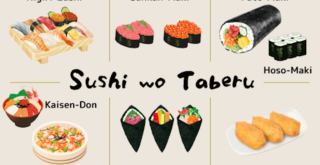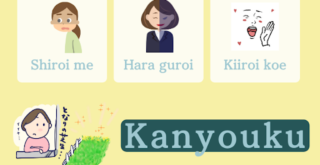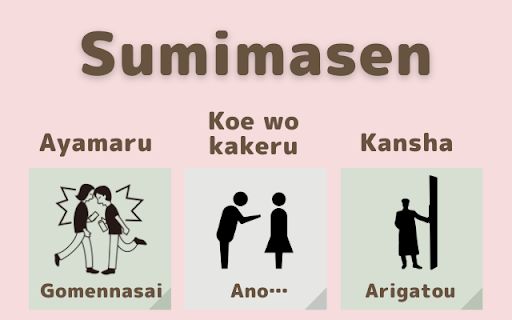
No Category
2023.02.25
Useful Japanese for Beginners【すみませんSumimasen】
In a previous column, I introduced "Daijyoubu" as a useful Japanese word that can be used by beginners. Today, I would like to recommend "Sumimasen" as the second useful Japanese word! "Suminasen" has several meanings depending on how you use it. When you apologize When you call out to someone When you show your appreciation At first, it may seem complicated, but if you know the situations in which it is used, it is not difficult to use it in conversation. "Sumimasen" is a common word used in everyday life. Once you understand how to use it, even beginners in Japanese will be able to communicate effectively. Here are some easy explanations of how to use "すみません sumimasen" in many different situations. "すみません Sumimasen" used when apologizing The word "sumimasen" is used to apologize. This is the same meaning as "gomennasai." It is a slightly more polite way of apologizing to someone you don't know or to someone you are not very close to. When you bump into someone: 「すみません」 " Sumimasen" When you are late for an appointment: 「すみません。おそくなりました」 "Sumimasen. I'm late." When you break something: 「すみません。コップをわってしまいました」 "Sumimasen. I broke a glass." Notes. When apologizing after a fight with a friend, you do not use "すみません sumimasen." In this case, it is "ごめんなさい Gomennasai." "すみません Sumimasan" used when calling out to someone. We use "sumimasen" as a word to call out to people. When there are people around the train door and you can't get through: 「すみません。おります」 "Sumimasen. I’m getting off." When you want to call an waiter at a restraunt: 「すみません。ちゅうもんをおねがいします」 "Sumimasen. Please take an order." When you want to ask a question: 「すみません。しぶやえきはどこですか」 "Sumimasan. Where is Shibuya Station." The word "sumimasen" is very common in everyday life. In many cases, it is used to address strangers rather than close friends. "すみません Sumimasen" used to express a gratitude The word "sumimasen" is also used to express your gratitude. It has the same meaning as "thank you," but is often used when someone is kind to you. When someone opened a door for you. When someone offered you a seat on the train When someone waited for you to get on the elevator. The word "sumimasen" to express your thanks can also be replaced by the polite "Arigato gozaimasu." Once you understand the three meanings of "sumimasen" and learn how to use it, you will enjoy Japanese conversation even more. Trying using "suminasen" and speak up at Ohanashi Kagawa!
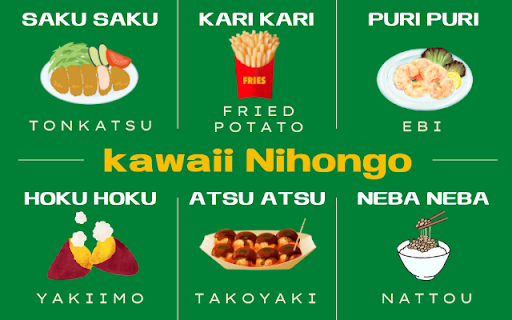
No Category
2023.02.25
Telling the Texture! Cute Japanese Expressions
What cute Japanese expressions do you know? Japanese adverbs include words that describe the state of things in detail. Words that are formed by combining words into a single word are called "Jogo (畳語)". For example: きらきら Kirakira さらさら Sara sara ほのぼの Hono bono すくすく Suku suku The word " Jogo" may sound difficult, but don't worry. Most Japanese people do not even know the word "Jogo". It is a simple word, but it is not the language of young children, and is commonly spoken and heard in daily life. It is casually used in various situations. In this issue, we will introduce some cute Japanese words related to the "texture of food." What is ふわふわ fuwa fuwa? What comes to mind when you hear the word "fuwa fuwa"? Most Japanese people think of bread. You see it in commercials and at bakeries as "fuwa fuwa bread" or "fuwa fuwa texture." Japanese people love soft and fluffy bread. Japanese words for texture like this remind us of what kind of food we are eating. And it is important to understand what kind of condition the food is in. Cute words to describe texture 「さくさく Saku saku」 Fried pork cutlets, fried shrimp, croquettes, tempura, and curry buns. Used when fried food is crispy. 「かりかり Kari kari」 French fries, well-cooked bacon, and small hard pickled plums Use for slightly hard and chewy foods. 「ぷりぷり Puri puri」 Shrimp, squid, and octopus. Used for firm and chewy foods. 「ほくほく Hoku hoku」 Sweet potatoes, pumpkins, and chestnuts. Often used for autumn foods. 「あつあつ Atsu atsu」 Ramen, soup, sukiyaki, and takoyaki. Used for foods cooked warm. 「ねばねば Neba neba」 Natto, okra, yams, and nameko mushrooms. Used for sticky foods. Is it different from onomatopoeia? Onomatopoeia is a language that uses verbal onomatopoeia, mimetic words, and gibberish to describe the state of things, movements, and animal noises. Wan wan, doki doki, za- za,Sube sube, and so on. Onomatopoeia is not only formed by combining words into a single word: はくしょん Hakushon がっかり Gakkari うんざり Unzari ガシャン Gashan パチン Pachin おぎゃー Ogyaa There are many different ways of expression. "Jogo" is a part of onomatopoeia. There are many more cute Japanese words to describe food. Let's check out what words are used for ingredients, cooking methods, and food conditions! You are sure to find a cute expression. How many words can you say to describe the texture? Let's talk about food at Ohanashi Kagawa!
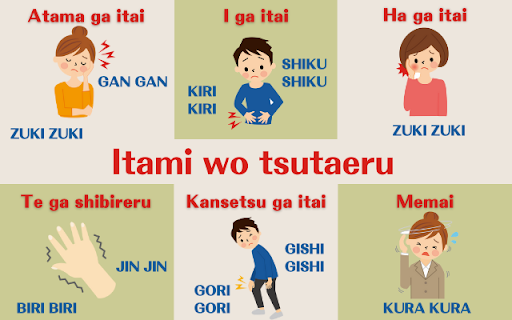
No Category
2023.02.25
Useful to Know! The Japanese Word for Pain
It is painful when you feel pain in your body. You may feel pain when you are sick, injured, or have stomach pain for an uncertain reason... There are many possible situations. In Japanese, we don't use difficult words to describe pain. It can be conveyed with onomatopoeia, a word made up of a single word combined with other words. For example, when you go to the hospital with a headache, the doctor may ask you: "What kind of pain is it?" How would you answer it? Throbbing (zuki zuki) Pounding (gan gan) We use these words when we have a headache. Today, I will introduce some useful Japanese words that you should know. This way, you could reduce stress of not being able to communicate well even though you are not feeling well. What kind of pain do you feel? When your tooth hurt ずきずき Zuki zuki When your finger is stuck in a door じんじん Jin jin When one has a stomach ache きりきり Kiri kiri しくしく Shiku shiku When you have a sore throat いがいが Iga iga When the limbs go numb じんじん Jin jin びりびり Biri biri When the skin is sunburnt ひりひり Hiri hiri When you have stomach ache ちくちく chiku chiku しくしく Shiku shiku When your bones or joints hurt ぎしぎし Gishi gishi ごりごり Gori gori When you have a burns and peeling skin ぴりぴり Piri piri ひりひり Hiri hiri Words to use when you're not feeling well Dizziness くらくら Kura kura Nausea むかむか Muka muka When the hands and feet are swollen ぱんぱん Pan pan When your heartbeat quickens どきどき Doki doki Will the hosipital understand? 「胃がきりきりと痛む」 "E ga kirikiri itamu (I have a splitting stomach ache)." Most Japanese can imagine what kind of pain it is. The expression "kiri kiri" is accepted as common knowledge. Of course, it is also understood in hospitals. When a doctor asks patients, 「どんな痛みですか」"What kind of pain do you have?" It is better to use onomatopoeia such as "zuki zuki," "gan gan," or "shiku shiku" to convey the pain more accurately than explain it in other ways. Things to watch out for It can be complicated until you get used to describing pain. When you feel a headache, you will realize that it is a throbbing feeling. It is hard to experience each pain separately. However, you must be careful not to use the wrong word for pain. Do not say, "Nodo ga gangan itai (my throat is pounding)," or "Atama ga shikushiku itai (I have a griping pain in my head)." Let's first try to apply onomatopoeia to the pain you experience. It is very useful to know what kind of pain you are experiencing by sensing the location of the pain and the symptoms. Let's have fun at Ohanashi Kagawa and learn about what expressions of pain we can use!
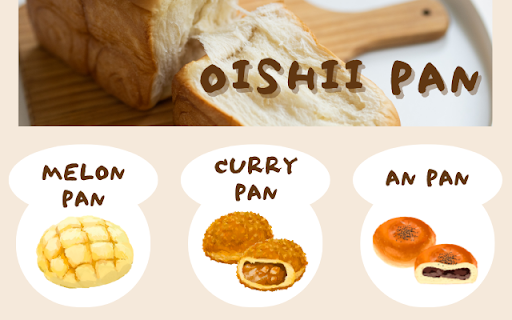
No Category
2023.02.25
Is Japanese Bread Special? Three Breads You Must Try
For those interested in Japanese food, I would like to recommend Japanese bread. Many of you might be familiar with Japanese bread. It has appeared in recent anime and manga, along with ramen and onigiri (rice balls). What makes Japanese bread so special is its softness. The fluffy texture of the bread will certainly surprise foreigners who are used to eating hard bread. You will also be surprised at the many varieties of bread available. There are many different types of breads to choose from, ranging from sweet dessert breads to side dish breads with ingredients on top. We recommend freshly baked bread from a bakery, but you can easily find good bread at convenience stores as well. Here are some breads I would like to recommend. When you visit Japan, be sure to try some of these breads. Cute looking メロンパン“Melon pan” Do you know why the melon pan got its name? There are several theories, but one is that it resembles a muskmelon because of the lattice pattern in its appearance. There is no melon in the bread. Some melon pan has a slight aroma of melon. The main feature of the melon pan is the use of cookie dough on top of the bread. At first bite, you will be surprised by the texture of the crispy cookie. Then, you will be impressed by the softness of the bread inside. Recently, there have been melon pans, like the one with cream. However, we recommend you try the simple melon pan. In Asakusa, Tokyo, there is a store that specializes in melon bread. Mysterious food? カレーパン "Curry pan" Curry pan is bread with curry inside. Furthermore, this bread is not baked in an oven but fried in oil. That is why the surface of the bread is crispy. The soft bread is filled with spicy curry, and it can be eaten as a snack or a lunch. There are different kinds of curry ingredients, depending on the bakery. Beef Curry Keema Curry Curry with lots of vegetables If you come across freshly fried curry bread at a bakery, it is worth a try! The classic flavor! あんぱん"An pan" Azuki beans are an essential part of wagashi (Japanese traditional sweets). There are two types of an: tsubu-an and koshi-an. Tsubu-an is made with the azuki bean skin left on, while koshi-an is made by removing the azuki bean skin and rubbing the azuki bean paste into a smooth paste. A pan is available in both koshi-an and tsubu-an. The soft buns are filled with a sweet bean paste that is not too sweet. Anpan is a perfect introduction to Japanese sweets. Why not give it a try? Let's talk about Japanese bread at Ohanashi Kagawa!
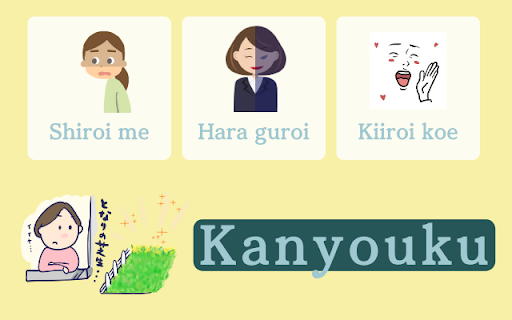
No Category
2023.02.25
Enriching Japanese Expressions! Idioms using colors
"Japanese is beautiful." "But it is difficult." When you are studying Japanese, you may face such challenges. But you don't have to worry about it. You can improve your language skills by learning Japanese with a curious mind. There are adjectives and adverbs in Japanese that express feelings or convey a state of feeling. You can use onomatopoeia to convey your feelings more clearly. Idioms may also be used to express yourself. Idioms can be difficult to master without thinking in their native language. But if you find the unique phrases interesting, you will be able to learn them. If you understand the idioms used in daily life, you will be able to express yourself more effectively in Japanese. Today, we will introduce some useful idioms using colors. What are “かんようく” idioms? Idioms are expressions that many Japanese are familiar with in their daily lives. Japanese idioms have been used for a long time. An idiom is a unique Japanese phrase made up of two or more words. It expresses a special meaning different from the original meaning of the word. A similar word is "proverb," but an idiom does not contain a lesson or saying and is a short expression. Idioms are used as metaphors for things. There are many unique phrases in Japanese, such as idioms using the body and idioms using animals. "かんようく"Idioms using colors ”Me no iro wo kaeru (目の色を変える)” To change one's eyes in response to anger, surprise, or other changes in emotion Example: "Sukina mono wo miruto meno iro ga kawaru." “Iromegane de miru (色眼鏡で見る)” To view people with preconceptions or prejudice. To have a biased view of things. Example: ”Shotaimen no hito wo iromegane de minaiyouni shiyou.” “Makkana uso (真っ赤な嘘)” An obvious lie. An absolute lie. An unmistakable lie. Example: ”Sorewa jijitsudehanai. Makkana usoda.” “Aka no tanin (赤の他人)” A complete stranger. An unrelated person. A person who has no connection to you. Example: “Anohito towa mattaku kankeiganai. Aka no taninda.” “Shiroi me de mirareru (白い目で見られる)” To be looked at coldly. To be looked at with suspicion. Example: “Densha no nakade oogoe de hanashitara, mawarikara shiroi me de mirareta.” “Hakushi ni modosu” (白紙に戻す)” To return to the original condition. To put things back the way they were. Example: “Jyoukenga awanai koto de kono torihiki wa hakushi ni modoshimasu.” “Me wo shirokuro saseru (目を白黒させる)” To be very surprised. To get surprised and flustered. Example: “Takarakuji ga attate me wo shirokuro saseta.” “Haraguroi (腹黒い)” People who plan things in their minds that are not good. People who are mean. People who plan to do bad things. Example: “Ano hito wa haraguroi kara kage de nani wo itteruka wakaranai.” “Kiiroi koe (黄色い声)” The high-pitched cheers of women and children. It's also called "Kiroi seien." Example: “Aidoru no consert kaijyou wa kiiroi koe de ippaida.” “Tonarino shiba wa aoi (隣りの芝生は青い)” The feeling of seeing other people's things better than your own. The feeling of envying others. Example: “Kochi no cake yori socchi no cake no hou ga oishisou ni mieruno wa, tonarino shiba ga aoku mirerudake.” This idiom is based on an English phrase (The grass is always greener on the other side. ). Let's have a fun conversation using idioms at Ohanashi Kagawa!
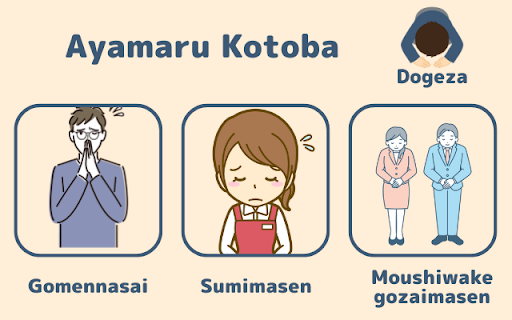
No Category
2023.02.25
Are Japanese good at apologizing? 3 Words for Apologizing in Japanese
Do you know how many "words of apology" there are in Japanese? The words you use depend on the situation: words for family and friends, words for people you are not close to, and words used in business situations. Compared to foreigners, Japanese people tend to apologize immediately. This is because many Japanese people think that when they bump into someone on the street, for example, it is not the other person's fault. Of course, there are people who blame the other person and get angry. In most cases, it is the Japanese who immediately say the words 「ごめんなさい」 "Gomennasai" or 「すみません」"Sumimasen." In Japan, it is not considered a loss if you apologize first. Being able to apologize properly is also a form of politeness in Japan. In this article, we will explain the types of words to use to apologize in Japanese and how to use them easily. Words of apology 「ごめんなさい」"Gomennasai" 「ごめんなさい」“Gomennasai” 「ごめんね」”Gomenne” 「ごめん」”Gomen” These are used to apologize to family members, friends, and those close to you. They are commonly used in everyday life. Words of apology 「すみません」 "Sumimasen” 「すみません」"Sumimasen" is used when you cause trouble for someone you don't know or don't know very well. It is a slightly more polite apology. For example: ・When you bump into someone on the street ・When you step on someone's foot on the train Words of apology 「もうしわけございません」"Moushiwake gozaimasen” 「もうしわけございません」"Moushiwake gozaimasen" is an apologetic phrase used in business situations. It is used in situations where you are apologizing politely. For example: When the cash register at a store is crowded, 「おまたせして、もうしわけございません」 "Omatasesite moushiwake gozaimasenn." When your order is taking a long time to arrive at a restaurant, 「もうしわけございません。もうしょうしょうお待ちください」 "Moushiwake gozaimasen. Mou shoushou omachikudasai." How to use the right words to apologize Let me explains how to use different words to apologize when you are late for an appointment. To a friend, 「ごめんね」 "Gomenne." At a hair salon 「すみません」 "Sumimasen." To a clients at work 「もうしわけございません」 "Moushiwake gozaimasen." Movement when apologizing There is also a gesture of apology. When used in combination with words of apology, it is more effective in expressing the sense of apology. 「ごめんなさい」 "Gomennasai" Clasping hands 「すみません」 "Suminasen" Bow your head 「申し訳ございません」 "Moushiwake gozaimasen" Bow your head. What is 土下座“Dogeza”? Kneeling on the floor or ground and placing one's hands on the ground to express an apology. It can be seen in historical and TV dramas. It is rarely used in everyday life. Kneeling on the ground is the highest level of apology. Summary It's better not to have too many opportunities to apologize. But if you know these three apology words, you can use them when the time comes. Are there opportunities to use words of apology at Ohanashi Kagawa?
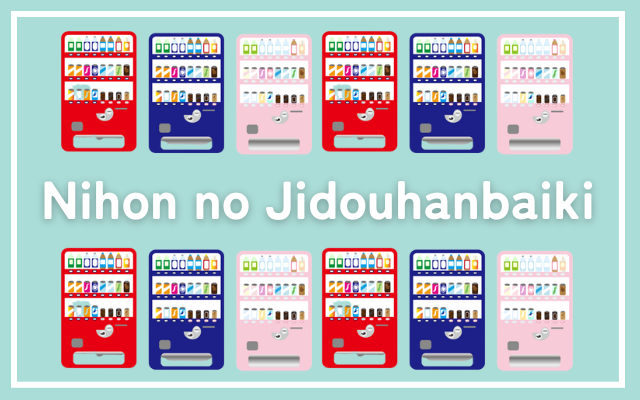
No Category
2023.02.11
Use the convenient Japanese vending machines!
When foreigners come to Japan, they are surprised at the number of vending machines. They will be surprised at how easily they can find vending machines in their daily lives. In Japan, vending machines are available anytime, anywhere, and whenever you want. There is no need to look around for a store just because you are thirsty. You can find a vending machine in no time. Isn't that convenient? In this article, I would like to introduce the convenient and useful vending machines in Japan. Convenience of vending machines Vending machines have become an important part of Japanese life. They are so familiar to us that we don't even realize how much we appreciate them when we live in Japan. Once you try using a vending machine, you will fall in love with its convenience. Easy to find vending machines Vending machines can be found throughout the city, on the streets, inside buildings, and beside the entrances to convenience stores. Even in rural towns without stores, vending machines can always be found. They can be found not only in downtown areas, such as in front of train stations but also in residential areas, allowing people to purchase drinks whenever they need them. Lots of different kinds of drinks Water, tea, juice, sports drinks, and coffee are the most common drinks sold in vending machines. Some machines have an assortment of corn soup, oshiruko (Japanese sweet red bean soup), and amazake (sweet sake), which is a good drink to have when it is cold. Most vending machines are managed by beverage manufacturers. So the types of drinks sold and their prices vary by a vending machine. Sometimes rare drinks that are not sold in convenience stores or supermarkets are sold. Finding your favorite beverage is part of the fun too. You can choose between cold and hot drinks What makes Japanese vending machines excellent is that cold drinks are properly refrigerated. If you are thirsty on a hot summer day, you can get a cold drink as expected. On a cold winter day, you might want a hot drink. Hot beverages such as tea, coffee, and soup are available too. The availability of cold and hot beverages from a single vending machine is a wonderful example of Japanese technology. Accepts cash as well as electronic money Cashless vending machines are spreading in urban areas. Although it varies from vending machine to vending machine, an increasing number of machines accept transportation-related electronic money such as Suica, and distribution-related electronic money such as Nanaco, WAON, and Rakuten Edy. At Narita and Haneda airports, there are vending machines that accept credit cards. It is possible that your first purchase upon arrival in Japan was a drink from a vending machine. Please note that some vending machines in rural areas only accept cash! Items sold in vending machines Beverages are not the only things sold in Japanese vending machines. There are many different types of vending machines. They range from the most common to the most unique. Some local stores have vending machines that sell unique local delicacies, so if you see one, why not give it a try? Ice cream Breads, pastries Cakes Cigarettes Beer Frozen dumplings Local gourmet Fresh flowers Let's talk about vending machines and drinks at Ohanashi Kagawa!
Learn Japanese
2023.02.10
Is Japanese-English complicated? Katakana with different meanings from English
Do you think Japanese is difficult? Learning to read and write is not easy. How about speaking and listening? The Japanese language has "katakana" to represent words from foreign languages. Katakana is used to represent words from foreign languages in Japanese. Once you get used to the Japanese pronunciation of katakana words used in conversation, you will be able to understand many words. For example: 「スターバックスでキャラメルフラペチーノとドーナツが食べたい」 "Starbucks de Caramel Frappuccino to donut ga tabetai." It is only a matter of time before you will be able to somehow understand what they are talking about. However, what you have to be careful of is Japanese-English, which has evolved uniquely in Japan. Many katakana are used in ways that are unrelated to their original meaning. In this article, we will introduce some complicated Japanese-English words that native English speakers should be aware of in Japan. バスルームはどこですか? "Where is the bathroom?" If you wanted to go to the bathroom and asked,「バスルームどこですか?」 "Bathroom wa dokodesuka?" where do you think you would be directed? It is the bathing room. In Japanese houses, toilets and baths are kept separate. So, we don't call the toilet a "bathroom." When you say,「バスルームに行きます」 "I'm going to the bathroom," at a Japanese friend's house, they might get surprised. チップスを食べる "Eating chips" When we speak of chips in England, we mean French fries. In Japan, chips mean potato chips. They are the same potato, but they are completely different foods. If you say to a Japanese friend, "I want chips," he or she may offer you nori sio (seaweed salt) flavored potato chips. スマートな人 "Smart person" What kind of person do you consider smart? Smart people, clever people, and stylish people come to mind, right? In Japan, the word "smart" is used to describe a person's physical shape. Slim people are called smart. Both are words of praise, but they have completely different meanings, so please be careful how you use them. サイダーを注文する "Order a cider" Cider is a drink in Japan. However, if you order it thinking it is cider, you will not get apple juice or apple wine. Cider is a clear carbonated juice in Japan. Of course, it is non-alcoholic. Ramune, a traditional drink, is also a type of cider. ドライバー "A driver" A driver is a person who drives a car. This is the same in Japan. But it also means "screwdriver" in Japan. It is a tool used to turn a positive or negative screw. And the club used to hit a golf tee shot (the first shot) is also called a "driver." So you need to determine which "driver" it is from the content of the conversation. Summary Japanese-English that differs from the original English meaning may be confusing. There are many foreign words in katakana. Once you get used to katakana, you will feel more familiar with the Japanese language! Let's have a fun conversation using katakana at Ohanashi Kagawa!
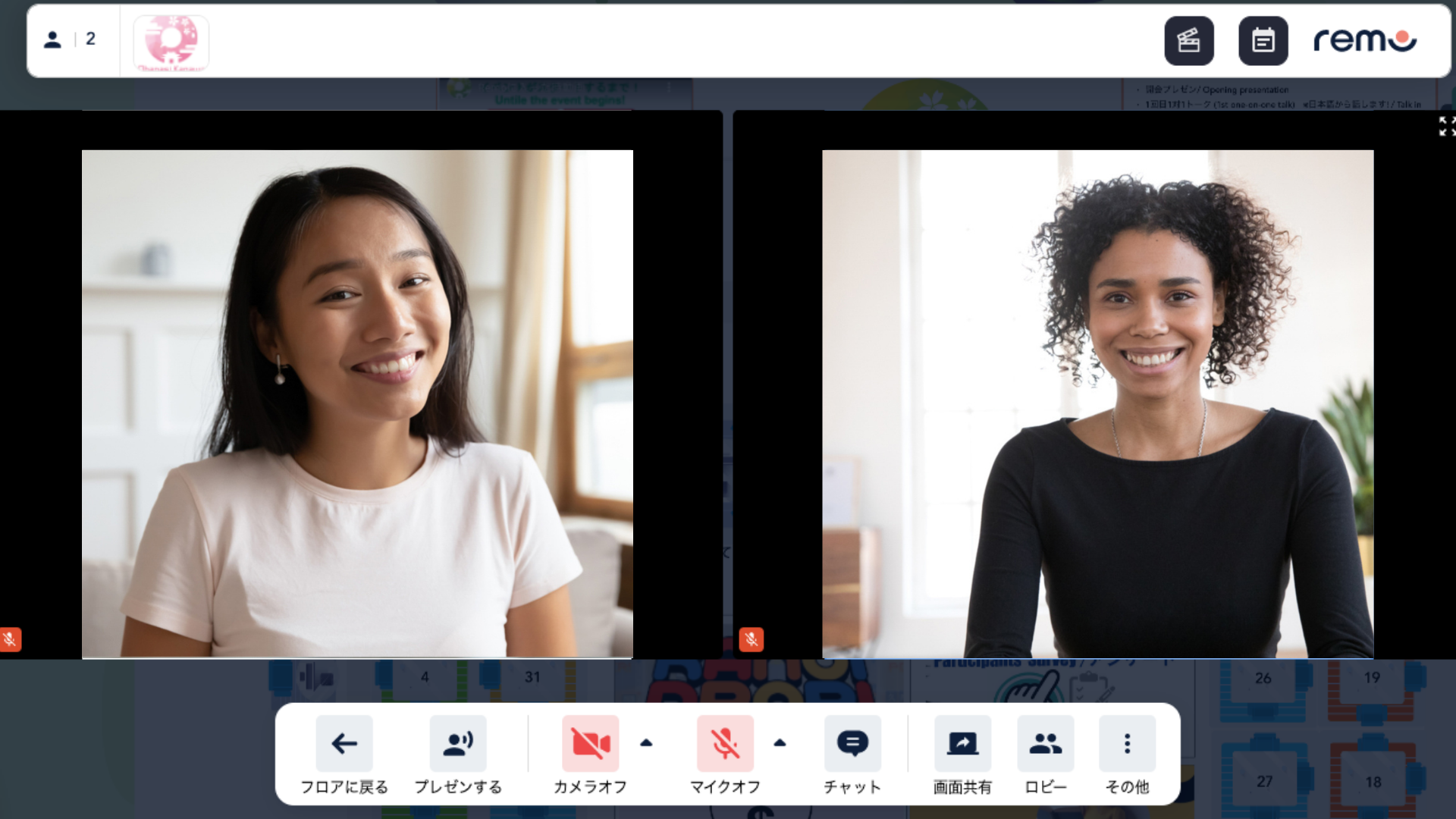
Ohanasi Kagawa
2022.12.10
Ohanasi Kagawa Event Participation Instructions
In this page, we will tell you how to participate in the Ohanasi Kagawa language exchange events from the Ohanasi Kagawa website. For detailed instructions on each step, please refer to the pages dedicated to each step. It may seem difficult at first, but it is actually very simple, so please read carefully until the end. Event Participation Flow 1 - Go to the Ohanasi Kagawa website and jump to the login page 2 - Sign up or log in and jump to the event reservation page 3 - Select the event you would like to attend from the event booking page 4 - From the event details page, click the Join button to book an event 5 - The Join button will appear only if you are able to attend the event at least 24 hours before the event starts 6 - Go to the event venue via the Join Event button that is displayed on your screen 7 - Wait for the opening presentation to begin 8 - Your seat number will be announced during the opening presentation 9 - Move to your seat after the opening presentation 10 - Start talking with your partner as soon as you are seated 1 - Go to the login page from Ohanasi Kagawa's website First of all, please click the Login or Sign Up button on the Ohanasi Kagawa website, or the banner or button on the event page to jump to the login page. 2 - Sign up or log in to jump to the event booking page If you are a new user, please register an account from the "Click here for account registration" section. Once you have registered for an account, you can log in by entering your e-mail address and password. 3 - Choose the event you would like to attend from the event booking page You can view event information from the event booking page. Click "View Event", "Event Title", "Event Banner", etc. to jump to the event details page. For more details on how to use the web application, click here. 4 - Book an event by clicking the Book an Event button from the event details page Click the " Book this event now" button on the event details page. If you do not need to use Tomodachi Kagawa, click the "Confirm" button to complete the event reservation. What is Tomodachi Kagawa? 5 - The participation button will be displayed only to those who can participate at least 24 hours before the start of the event When you book an event, buttons like the one in the image below will appear on the "Event Page" and "My Page". You will only be able to view participation status until 24 hours before the event starts. 24 hours before the event, the application will balance the number of participants and only those who can participate on a first-come, first-served basis will be shown the button to enter the event. What is the participant status? Not sure if you can participate? About cancellations 6 - Go to the event site from the event join button displayed Clicking the "Enter Event Venue" button will take you to the event venue (Remo). You will not be able to enter the event venue until the event start time. When it is time for the event to start, please follow the procedure in Remo to enter the event venue. If you cannot enter the event venue, please let our staff know via chat. Contact us 7 - Wait for the opening presentation to begin When you enter the venue, please turn on your camera and microphone first. Until the opening presentation begins, you can either chat with other attendees, wait in the break area, or listen to explanations from the staff at the beginner's table. To move around, double-click on the seat you wish to occupy. The timer above will display the time until the opening presentation begins. What to do if you have a problem at the event venue? How to deal with mechanical troubles Regarding basic operation of Remo 8 - Seat numbers announced during an opening presentation When the opening presentation begins, staff will welcome you and play a video describing the event. After that, please check the general chat as your name and seat number will be announced in the general chat. (You can check your name and seat number from the general chat on your chat button even after the presentation is over.) Click here for basic Remo operation. 9 - Move to your seat after the opening presentation Double-click on your seat to go to your seat after the opening presentation. If you want to check your seat, please click the "Chat" button next to the camera and microphone, and press the "General Chat" button. If you are unable to move or are unsure of your seat, please come to the central staff room or chat with the "Event manager" in the chat room. What if I need help at the event? 10 - Start a conversation with your partner as soon as you are seated When you arrive at your seat, please start a conversation with your partner for 15 minutes in Japanese and 15 minutes in English. Our staff will be patrolling the room, so if you have any trouble, please call us anytime. Also, if you have any trouble while talking with your partner, please let our staff know via chat or come directly to the staff room. What if I have a problem at the event venue? Conclusion How was it? We hope that by understanding the general procedure of Ohanasi Kagawa events, it has made it easier for you to participate in our events. I am sure you will be very nervous at the beginning. However, please feel free to come to the event as there are many staff members who will be patrolling and supporting you for this purpose. We are sincerely looking forward to your participation. Join Ohanasi Kagawa events →.
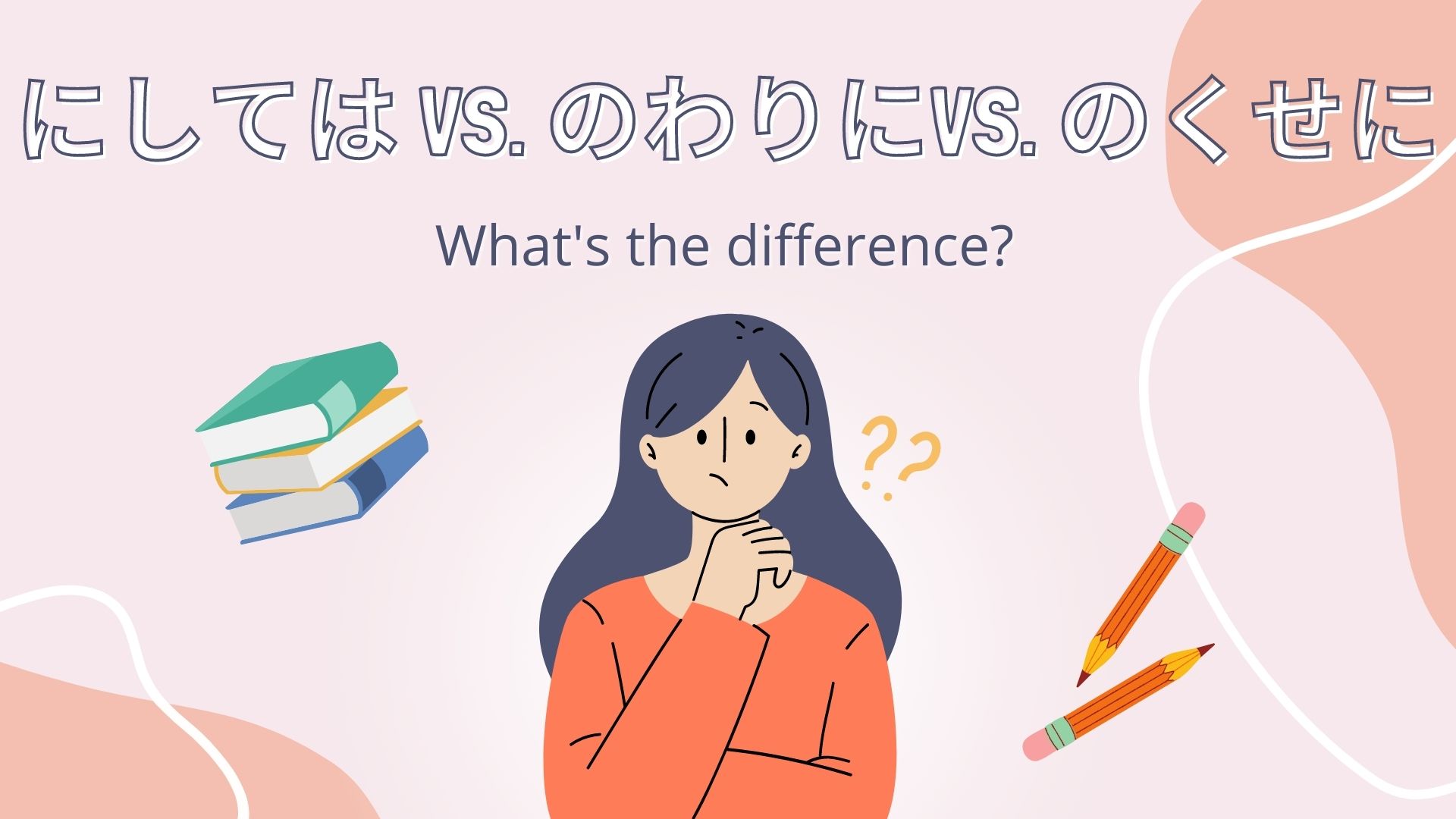
Learn Japanese
2022.12.10
What is the difference between “にしては”, “のわりに”, and “のくせに”?
When you are learning Japanese, you may be confused by the many expressions with similar meanings. This time, I will explain three different expressions: "にしては", "のわりに", and "のくせに", and compare them. Let's check the meaning of these expressions and see when you can use them! "にしては", "のわりに", and "のくせに" are expressions used when the result is different from what you expected or hoped for. For example, if you say, "このおかし、¥100にしてはおいしいね! (This candy tastes great for 100 JPY!) it means that you expected that the taste would not be so good for 100 JPY, but it turned out delicious. In the same way "このおかし、¥100のわりにおいしいね!"(This candy tastes good even though it costs only 100 yen.) "このおかし、¥100のくせにおいしいね!"(This candy tastes good even though it costs 100 yen.) you can say like this, but there are some differences. First of all, "くせに" has an insulting implication. "¥100のくせに (Even though it's only 100 yen)," which implies that you are looking down on a 100-yen snack. In addition, you can often use "にしては" when your thoughts differ from what is generally expected, and "のわりに" when your subjective expectations differ from what is generally expected. So when you want to express your personal opinion, you use "のわりに". It is also important to remember that you cannot use "~にしては" after an adjective. You can say, "このおかし、やすいわりにおいしいね!(This candy tastes great even though it is cheap!)" , but "このおかし、やすいくせにおいしいね!(This candy tastes great despite its cheap price!)" sounds like a sarcastic compliment. As you can see, there are slight differences in the usage of "にしては", "のわりに", and "のくせに". If you have a chance to come into contact with Japanese, please pay attention to which one they are using. Let's increase your knowledge of the Japanese language and enjoy learning Japanese even more! Even so, it's hard to understand the differences in grammar. There is no one nearby who can teach me the differences in grammar in an easy-to-understand way. I want to learn grammar more clearly. Have you ever thought like that? At our online Japanese language school, we have prepared original teaching materials and curriculum to help you learn Japanese grammar in an easy-to-understand way. Wouldn't you be happy if you could master Japanese grammar and become more confident in speaking Japanese? If you are interested in our online Japanese Language School, click the link below to see more information. Learn more



